文章目录

动态内存基础

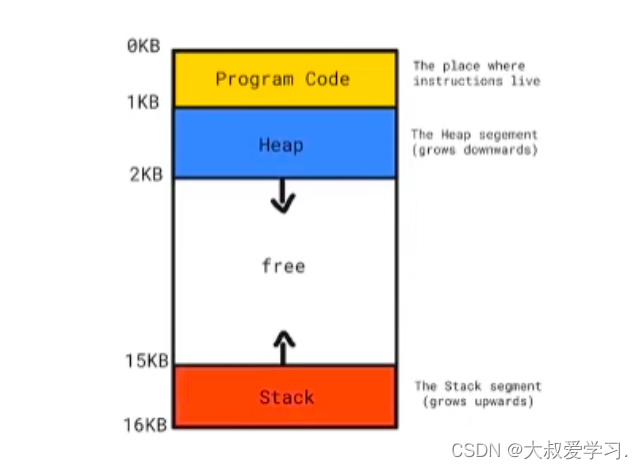
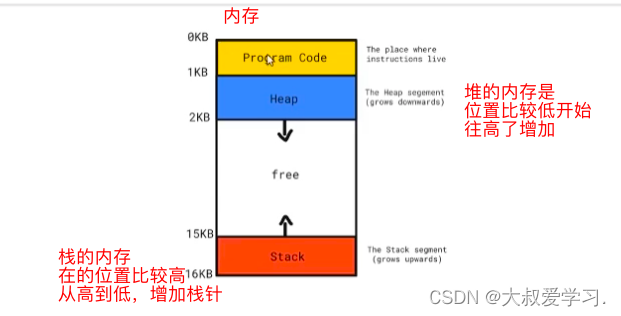
栈的对象在内存中开辟的空间都比较紧密,连续创建的对象x和y,他们在栈空间是非常紧密的。函数调用,栈针就会出栈。函数结束,对象就自动销毁了。
堆是在运行期动态扩张。因为有的时候,需要多少内存,是在运行期才能确定的。所以就需要堆。比如刚开始分配了10个int的内存,使着过程中,发现不够用了,再分配20个int。这就是动态的扩展内存,动态缩小内存也同理。
对比栈的内存,栈针弹出会自动销毁。但是堆不会,需要通过delete进行释放。
如果控制堆内存呢?我们通过new和delete来构造、销毁对象。
栈内存:
int main()
{
int x; // 系统在栈中开辟一块内存给x
x = 2; // 在x这个内存位置把2写入
cout << x << endl; // 系统会把x对应内存的数值取出来,传递给cout
}
堆内存:
int main()
{
int* y = new int(2); // 由new分配了一块堆内存,int有多大,就分配多大
// new返回的是一个内存的地址,我们需要用一个指向该堆内存的指针来接收
cout << *y << endl; // 对地址解引用,才能获得堆内存里的值
//...
delete y; // 告诉系统y对应的内存我,我们不需要了
}
int* fun()
{
int* res = new int(2);
return res; // 返回堆内存res对应的地址
}
int main()
{
int* y = fun(); // 因为我们fun函数开辟的是堆内存,返回是堆内存的地址
// 所以函数结束,堆中对象还在,y可以取到
cout << *y << endl;
//...
delete y; // 告诉系统y对应的内存我,我们不需要了
}
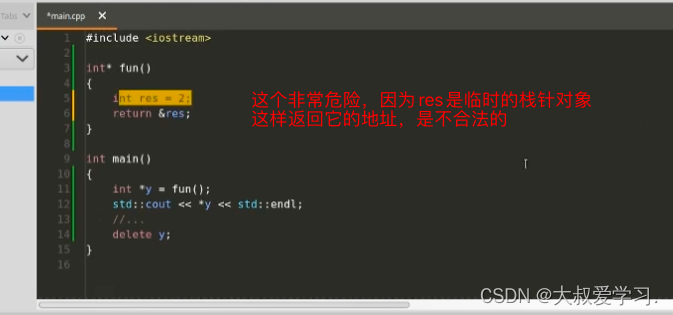
int* fun()
{
int res = 2;
return &res; // warning: address of stack memory associated with
// local variable 'res' returned [-Wreturn-stack-address]
}
int main()
{
int* y = fun();
cout << *y << endl;
//...
delete y;
}
对象的构造:1分配内存;2在内存上构造对象;
对象的销毁:1对象销毁;2把之前分配的内存归还给系统;
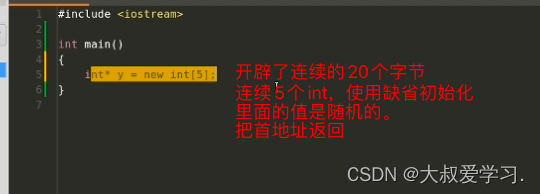
int main()
{
int* y = new int[5]{1, 11, 22, 33, 44};
cout << y[1] << endl; // 11
delete[] y; // 构造的数组,要加[]来删除
}
内存片段:有时候我们分配了一大块连续的内存,但是释放的时候,可能只是释放了其中一部分零散的内存,所以不连续。
通过nothrow new来判断分配内存是否成功。如果失败了,系统不抛出异常,而是返回一个nullptr的指针。
#include <iostream>
#include <new>
using namespace std;
int main()
{
int* y = new(std::nothrow) int[5]{1, 11, 22, 33, 44};
if (y == nullptr)
{
//...
}
else
{
cout << y[1] << endl;
delete[] y;
}
}
palecement new:不需要分配内存了,只需要在已分配的内存上构造对象。vector就是用这个原理。vector动态增长。
vector增加一个元素的原理不是:若来了一个新的元素,先开辟一块新的内存,把原有的值拷贝过来,再把新的元素放进来。vector一般不这么做,而是多分配一些。这样不用一直拷贝。
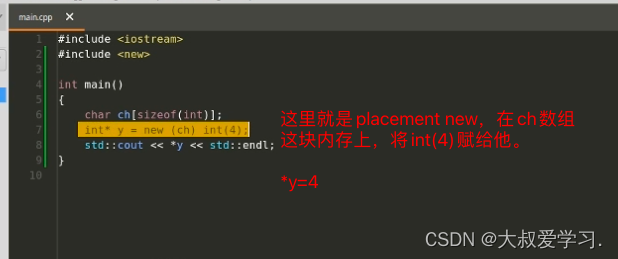
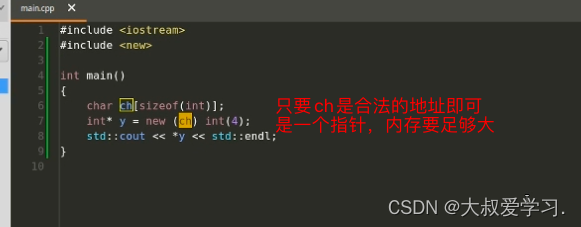
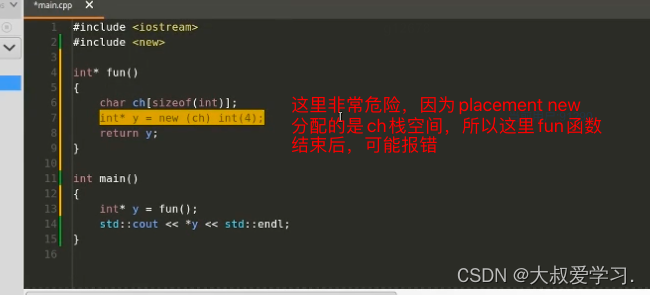
int main()
{
int* y = new auto(3); // new auto 系统自动推导
}
new与对象对齐
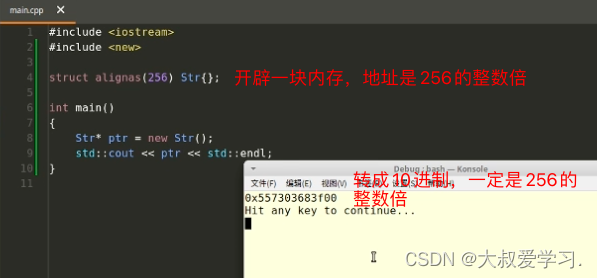
delete
int main()
{
int* ptr = new int;
delete ptr;
int* ptr2 = new int[5];
delete[] ptr2; // 销毁数组
}
placement delete:只关注内存上构造的对象销毁掉,但是不会把内存归还给系统。还是vector的删除一个元素的原理,只会把最后一个元素销毁掉,但是对象对应的内存并不归还给系统。
对于内建的类型,不需要考虑placement delete。只有我们定义了类的析构函数。析构函数会刷新缓存,关掉文件。
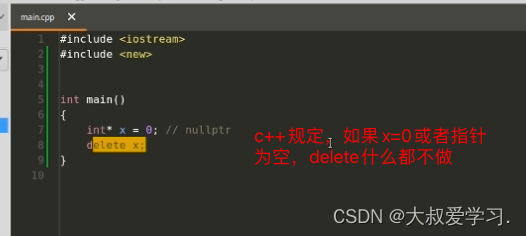

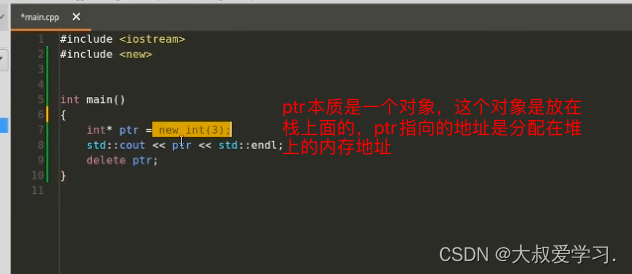
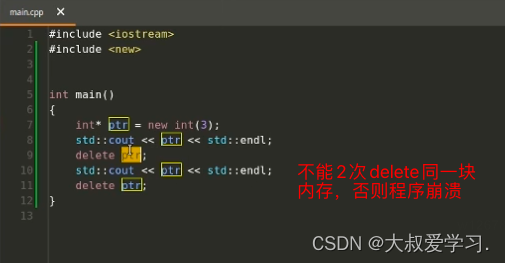
int main()
{
int* ptr = new int(3);
cout << ptr << endl; // 0x7fbec9c05a30
delete ptr;
ptr = nullptr;
cout << ptr << endl; // 0x0
delete ptr; // ptr=nullptr系统什么都不做
}
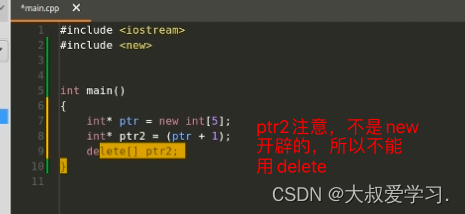
智能指针

new和delete是关系很紧密的两条语句,但是什么时候调用delete我们说不清,容易产生不销毁或者多销毁,而且还有内存所有权的问题。所以引入了智能指针的概念。
Shared_ptr——基于引用计数的共享内存解决方案
int main()
{
// int* x = new int(3); 之前的写法
// int* x(new int(3));
//int* 等价于 std::shared_ptr<int>
std::shared_ptr<int> x(new int(3)); //x是shared_ptr构造的对象,new int(3)初始化x
cout << *x << endl; // 3
}
share_ptr是一个智能指针,它的机制是引用计数,通过引用计数来维护内存什么时候进行销毁。我们不用担心内存泄漏,整个x在main结束,x的生命周期结束,x是一个share_ptr包含一个析构函数,x结束,析构函数销毁new int构造的内存。
#include <iostream>
#include <new>
#include <memory>
using namespace std;
int main()
{
std::shared_ptr<int> x(new int(3)); // x包含两个信息,一个是3,另一个是引用计数:1
// 引用计数,同一时刻,有多少对象引用它
std::shared_ptr<int> y = x; // 同样不担心程序执行完new int没有被销毁,这时引用计数是:2
// y和x共享一个引用计数对象,c++规定先构造的后销毁,后构造的先销毁
// y先销毁(调用shared_ptr<int>析构函数),new int(3)的引用由2变成1
// 再销毁x(调用shared_ptr<int>析构函数)
// 由于引用计数的存在,保证内存被销毁,且不会销毁多次
}
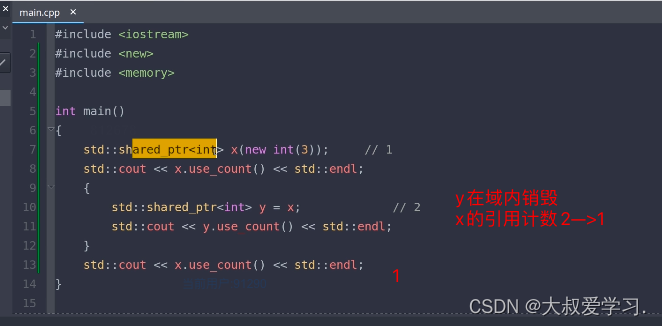
get()
#include <iostream>
#include <new>
#include <memory>
using namespace std;
std::shared_ptr<int> fun()
{
std::shared_ptr<int> res(new int(3));
return res;
}
int main()
{
auto y = fun();
cout << *y << endl; // 智能指针本质是指针,对其解引用,返回3
cout << *(y.get()) << endl; // 3, y.get()返回int*
}
#include <iostream>
#include <new>
#include <memory>
using namespace std;
std::shared_ptr<int> fun()
{
std::shared_ptr<int> res(new int(3));
return res;
}
void fun2(int* x)
{
}
int main()
{
auto y = fun();
cout << *y << endl; // 智能指针本质是指针,对其解引用,返回3
cout << *(y.get()) << endl; // 3, y.get()返回int*
// fun2(y); // 报错 note: candidate function not viable: no known conversion from 'std::shared_ptr<int>' to 'int *' for 1st argument
fun2(y.get()); // 确保实参是int*
}
reset()
#include <iostream>
#include <new>
#include <memory>
using namespace std;
std::shared_ptr<int> fun()
{
std::shared_ptr<int> res(new int(3));
return res;
}
int main()
{
auto y = fun();
y.reset(new int(100));
cout << *y << endl; // 100, reset尝试释放y包含的指针的资源
// 然后接受一个新的指针,引用计数+1
}
指定内存回收逻辑:把内存放在一个池子里,一般从内存池里拿,不用的的时候放回池子里,不涉及new和delete操作,可以提升速度。
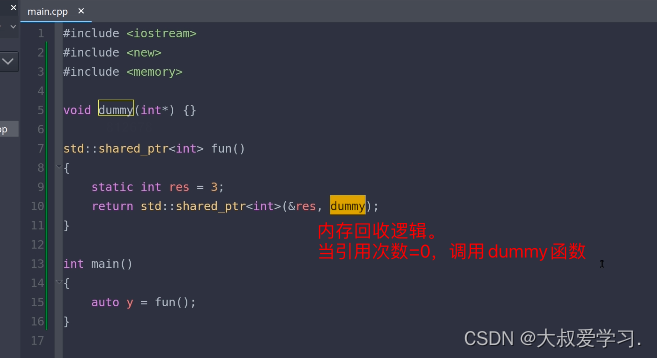
make_shared
#include <iostream>
#include <new>
#include <memory>
using namespace std;
int main()
{
std::shared_ptr<int> ptr(new int(3));
// 等价于下面的
std::shared_ptr<int> ptr2 = std::make_shared<int>(3);
auto ptr2 = std::make_shared<int>(3); // 简化代码
// make_shared 确保局部性,分配一块内存,把3写入,系统还要构造引用计数
// make_shared 进行了优化,把2块内存放的尽量近
// 好处是读取引用计数和int时,只访存1次,提高效率
}
支持数组
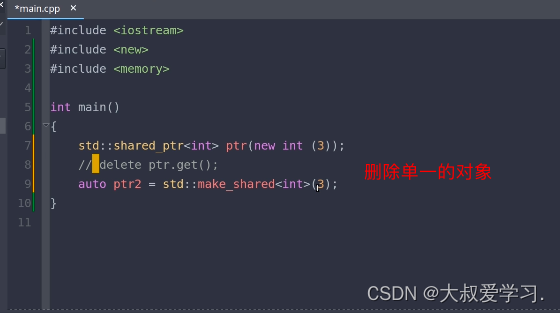
int main()
{
std::shared_ptr<int[]> ptr(new int[5]); // int[] 告诉系统用delete[] 进行删除
}
c++20可以用make_shared
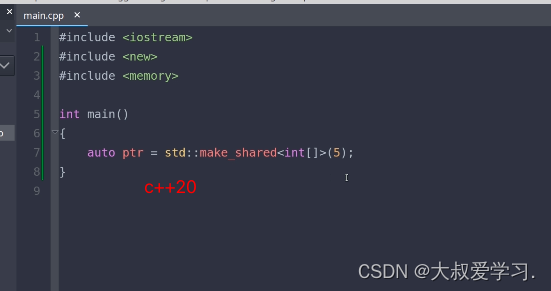
注意: shared_ptr 管理的对象不要调用 delete 销毁
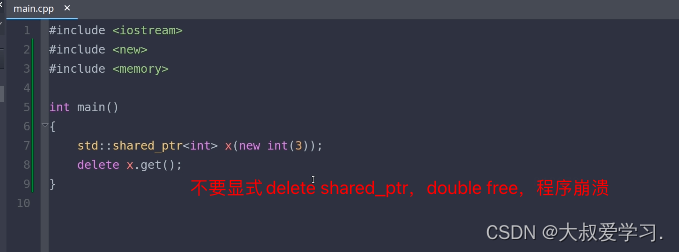
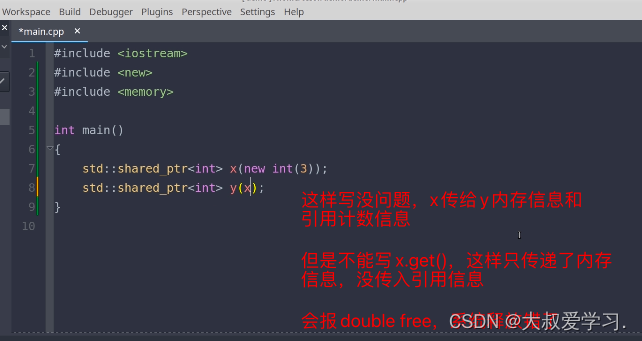
unique_ptr——独占内存的解决方案
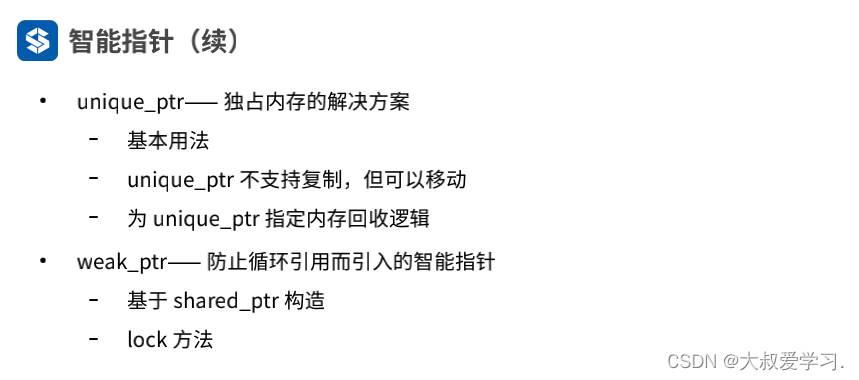
一般意义指针就是共享的行为,但是不排除独占的时候。就要用unique_ptr
#include <iostream>
#include <new>
#include <memory>
using namespace std;
int main()
{
std::unique_ptr<int> x(new int(3)); // x是独占int(3)这块内存资源的
// std::unique_ptr<int> y(x); // 报错,y不能共享x的内存
}
int main()
{
std::unique_ptr<int> x(new int(3));
cout << x.get() << endl; // 0x7fbeeb405a30
std::unique_ptr<int> y = std::move(x); // x将亡值,x的资源给y
cout << x.get() << endl; // 0,y拿走了x的资源
cout << y.get() << endl; // 0x7fbeeb405a30
}
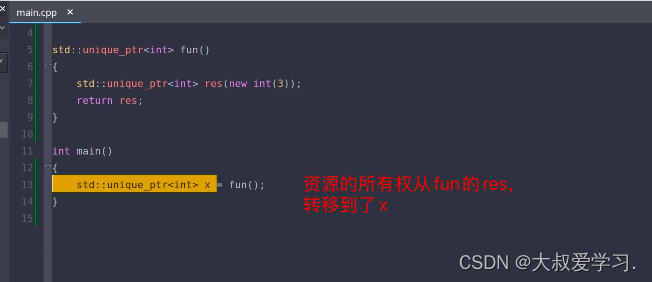
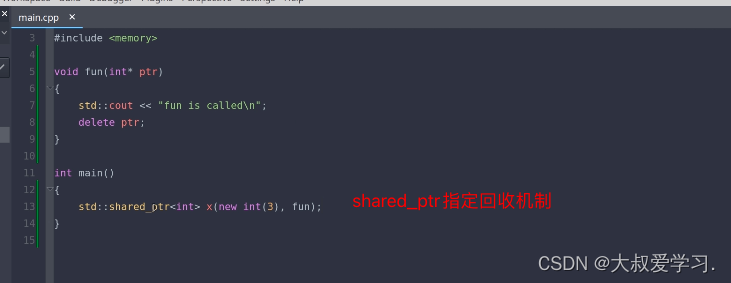

weak_ptr——防止循环引用而引入的智能指针
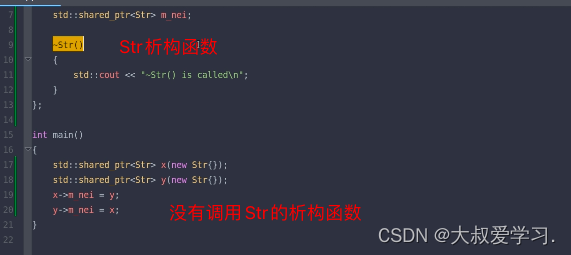
shared_ptr通过引用计数来销毁。但是17-20行
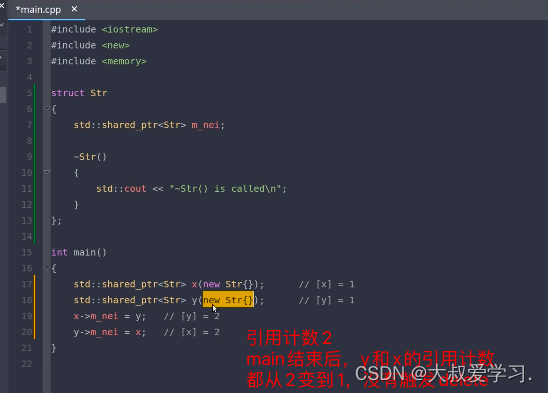
所以要解决循环引用,使用weak_ptr来解决。
weak_ptr可以和shared_ptr共享一块内存,但是weak_ptr并不会增加引用计数。这样就解决了循环引用的问题。
动态内存的相关问题
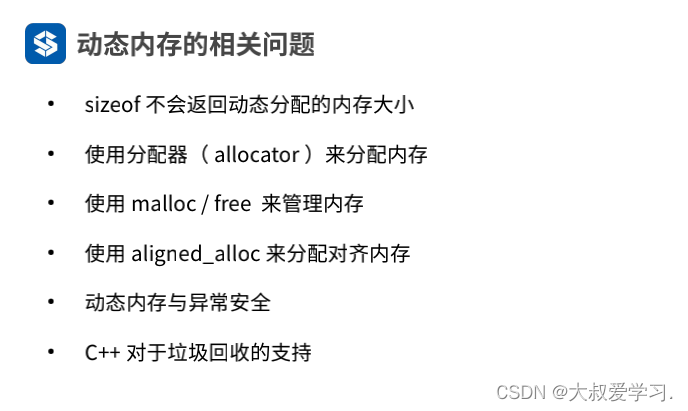
sizeof不会返回动态内存的大小:
#include <iostream>
#include <new>
#include <memory>
using namespace std;
int main()
{
int* ptr = new int(3);
cout << sizeof(ptr) << endl; // 8 ptr是一个int*,8个字节
int* ptr2 = new int[3];
cout << sizeof(ptr2) << endl; // 8 ptr是一个int[]的起始地址,8个字节
// new返回的是内存的地址,sizeof返回的一定是int*的大小
// sizeof并不会返回int*指向内存对象的尺寸
}
使用分配器( allocator )来分配内存
对象的构造分2步:1分配内存;2构造对象
allocator成员函数:
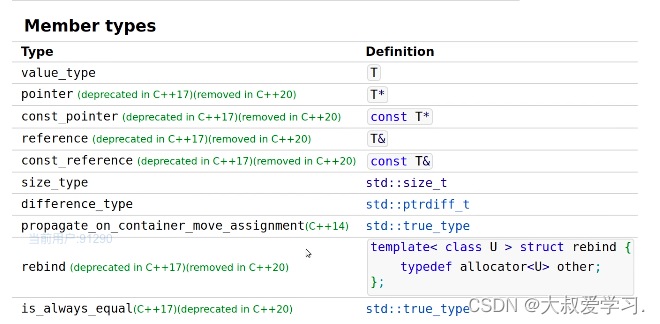
allocate分配内存
int main()
{
std::allocator<int> al; // 分配器al,用来分配int类型的对象
int* ptr = al.allocate(3); // 分配了一块内存,这个内存可以包含3个int,然后返回
// 注意这里不是构造了3个int的内存。
// 差异在于allocate不包含int的初始化,只是内存分配,不初始化。
}
deallocate回收内存
int main()
{
std::allocator<int> al; // 分配器al,用来分配int类型的对象
int* ptr = al.allocate(3); // 分配了一块内存,这个内存可以包含3个int,然后返回
al.deallocate(ptr, 3); // 释放内存
}
使用 malloc / free 来管理内存
malloc / free另外一对内存管理的方法。对比new和delete。既然有了new和delete,为什么还要这个呢?malloc / free 继承自c语言。new和delete都包含2个操作,分配和对象。但是malloc和free只会分配内存,不会在内存上构造对象,因为c语言内部,不是很强调对象的构造。c++引入类之后,才强调对象的概念。
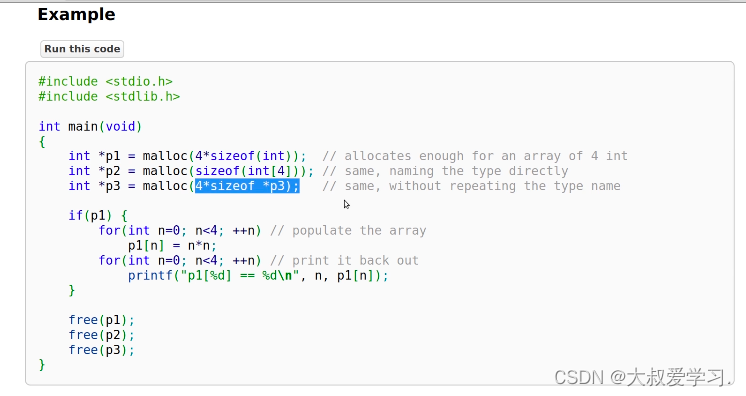
但是mallo不保证内存的对其,所以引入了aligned_alloc来分配内存对齐
使用 aligned_alloc 来分配对齐内存
如果有可能还是使用allocator。
动态内存与异常安全
#include <iostream>
#include <new>
#include <memory>
using namespace std;
int main()
{
int* ptr = new int(3);
//...这里可能会有异常,
// 异常:程序不应该出现的状态
// 系统会跳到异常捕获,去处理异常
// 如果系统发生异常,这里就不会执行13行了,内存就没有释放
delete ptr;
}
如果内存没有及时释放,内存在堆上不断的激增,最后导致系统崩溃。
#include <iostream>
#include <new>
#include <memory>
using namespace std;
void fun()
{
std::shared_ptr<int> ptr(new int(3));
//...
//
}
int main()
{
//...
// 因为用了shared_ptr智能指针,不论调用多少次fun,内存都可以被释放,提升安全性
}
C++ 对于垃圾回收的支持
垃圾回收:动态指定了内存,现在不用了,需要回收掉。python,java都支持垃圾回收。系统会判断内存没有使用,然后自动回收。c++对于垃圾回收可以说是欲拒还迎的状态。
